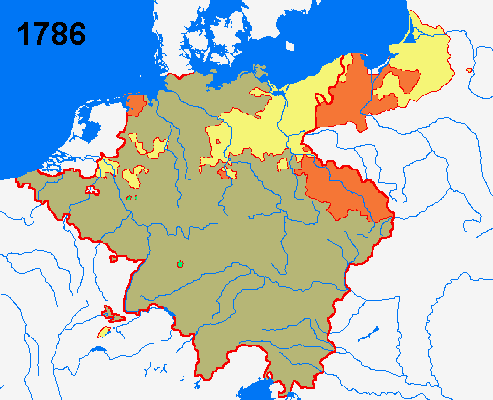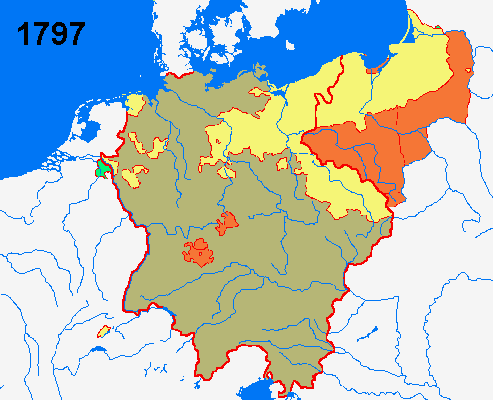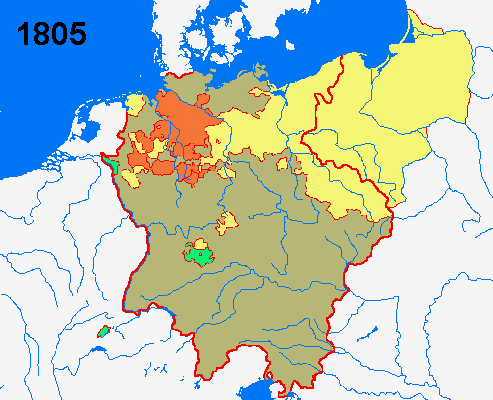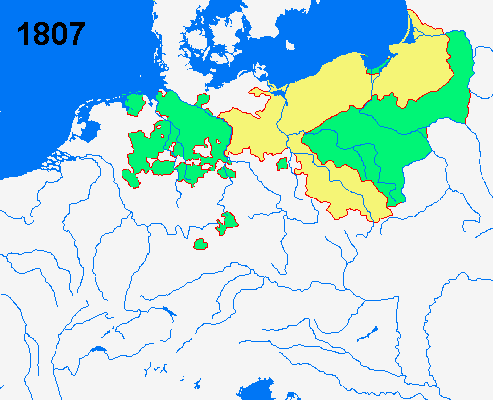|
Prussia 1740-1807

 = Prussia 1740
= Prussia 1740
 = Territorial gains
= Territorial gains
 = Territorial losses
= Territorial losses
 = Other principalities in the Holy Roman Empire
= Other principalities in the Holy Roman Empire
When Friedrich the Great succeeded his father as King of
Prussia 1740 he inherited a large and well-trained army which he unlike
his father would use frequently. The same year Maria Theresia inherited
the Habsburg lands, her father Karl VI had to no use acquired guarantees
for her succession in all parts of the Habsburg empire. Friedrich the
Great was the first who challenged her inheritance when he started the
First Silesian War 1740-1742, this move encouraged other states to attack
Austria whereby the War of the Austrian Succession broke out. Friedrich
the Great’s successes forced Maria Theresia to conclude peace with Prussia
by ceding Silesia 1742. But Friedrich feared an attack from Maria Theresia
when Austria’s fortunes of war against her other enemies turned and he
decided therefore to attack first and start the Second Silesian War
1744-1745. The Prussian army was once again successful and Prussia’s
possession of Silesia was secured in the following peace, but the price
for that conquest was a long-lasting enmity between Prussia and Austria. A
more peaceful territorial gain at the same time was the inheritance of the
county of Ostfriesland 1744.
Austria had not given up the hope to regain Silesia and
Maria Theresia forged a powerful coalition against Prussia consisting of
Austria, Russia, France, the Holy Roman Empire and Sweden. Prussia’s only
allies were Great Britain with Hanover and a few small German
principalities, but Friedrich the Great also possessed the Prussian army
that was widely admired in Europe for its capabilities. In 1756 he
forestalled his enemies by attacking Saxony, which he hoped to incorporate
with Prussia. But unlike the Silesian Wars Friedrich failed to deliver a
quick decisive blow to the Austrian army. Instead for the expected short
war the conflict developed into a seven year long war of attrition in
which the Prussian army despite of several successive battles were
shrinking fast and gradually pressed back. The only thing that saved
Prussia from being wiped out from the map was the dissolution of the enemy
coalition as a result of Friedrich’s admirer Peter III’s ascension to the
Russian throne.
After the peace 1763 Friedrich was forced to spend much
effort to rebuild his war-torn kingdom and severely depleted army. But a
new significant territory was gained when Prussia participated in Poland’s
first partition 1772 with Austria and Russia whereby the land between the
original Prussian duchy and Brandenburg was incorporated. Friedrich the
Great was also successful in frustrating Austria’s attempts to expand in
Germany, which was the cause to the War of the Bavarian Succession
1778-1779. When Friedrich died 1786 he left a kingdom that was
considerably larger than the one he had inherited and which possessed an
incredible prestige in Europe, most of all for its 200 000 men strong army.

 = Prussia 1786
= Prussia 1786
 = Territorial gains
= Territorial gains
 = Territorial losses 1795
= Territorial losses 1795
Friedrich Wilhelm II’s reign 1786-1797 was despite of
territorial expansion marked by a weakening of Prussia’s power. Poland’s
second and third partition 1793 and 1795 together with the inheritance of
the margraviates of Ansbach and Bayreuth meant a great increase of
Prussia’s territory, but it could not hide the fact that its finances and
the quality of its army was deteriorating. This was shown in the Polish
campaigns and the Revolutionary War in which Prussia lost all lands west
of the Rhine to France 1795.

 = Prussia 1797
= Prussia 1797
 = Territorial gains
= Territorial gains
 = territorial losses 1805
= territorial losses 1805
The successes of Napoleons were at first beneficial for
Prussia which remained neutral but relatively friendly towards France. The
redrawing of the map over Germany meant that several smaller
principalities, imperial cities and church lands were confiscated and
redistributed primarily to the medium-sized principalities. Prussia gained
the dioceses of Hildesheim and Paderborn, parts of Münster and Mainz, the
imperial cities of Nordhausen and Goslar and other areas. In 1805 were
Neuchatel, Ansbach and Kleve exchanged for Hanover, which Napoleon had
occupied. This brought Prussia into a conflict with Great Britain who’s
king was also elector of Hanover, most of Prussia’s merchant fleet was
therefor sunk by the British navy.

 = Prussia 1805
= Prussia 1805
 = Territorial losses 1807
= Territorial losses 1807
The year 1806 is the darkest year in Prussia’s history.
After Napoleon had forced the dissolution of the Holy Roman Empire Prussia
became also formally an independent state. But when France promised to
return Hanover to the British king in exchange for peace Friedrich Wilhelm
III (1797-1840) made the fatal decision to declare war against France. In
the dual battle of Jena and Auerstädt the Prussian army was crushed and
French troops occupied most of Prussia. It was only pressure from Russia
that prevented Napoleon to dissolve the Prussian State altogether. But
when peace was concluded 1807 Prussia was reduced to a second rate nation.
The history of Prussia continues on the next page. |

